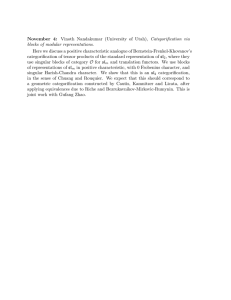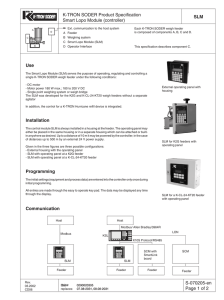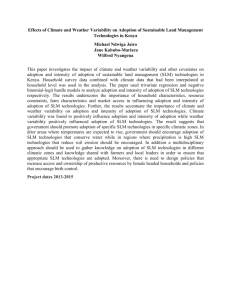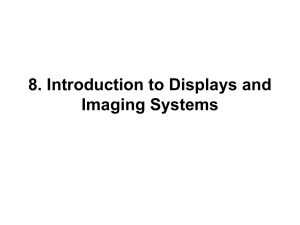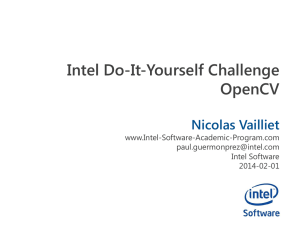Laser scanning with spatial light modulators
advertisement
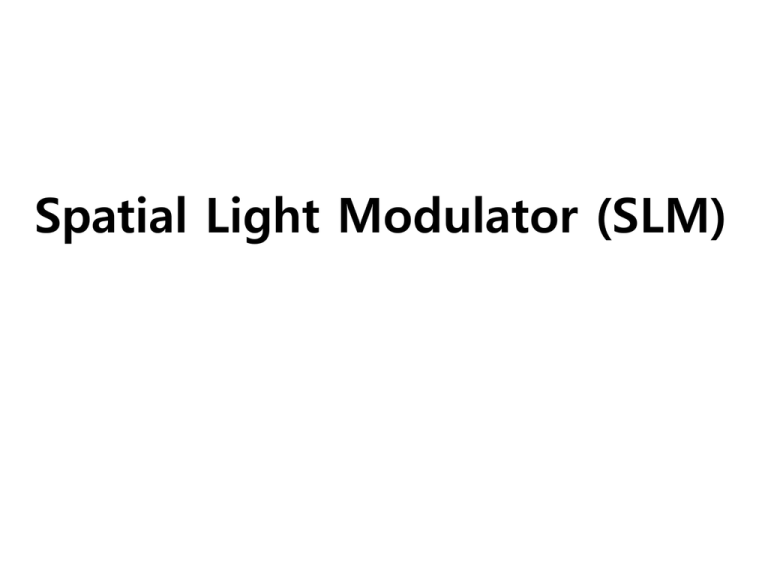
Spatial Light Modulator (SLM) What is SLM? • An device that imposes some form of spatially-varying modulation on a beam of light. • It can modulates the intensity or phase of the beam or both the intensity and the phase simultaneously. Hamamatsu X10468 Series • Liquid crystal on silicon (LCOS) chip based Phase-Only Modulator • • FEATURES ・ Pure, linear and precise phase control ・ High light utilization efficiency ・ High diffraction efficiency ・ Compact ・ Ease of use(DVI compatible) ・ Reflective type LCOS chip APPLICATIONS ・ Laser material processing ・ Optical manipulation ・ Wavefront correction ・ Pulse shaping ・ Optical testing Hamamatsu, X10468 series manual, 2009 Specifications How it works Ai A0 ei0( x, y) Hologram TEM00 Ao TSLM Ai LG01 y LG01 Hologram ( x, y) tan 1 x Transmittance at SLM TSLM ( x, y) A( x, y)ei ( x, y ) where, A( x, y) 1 By modulating the phase of incident light, the intensity of output light can be changed. Phase Modulation Characteristic • The X10468 series can achieve phase modulation of more than 2π radians over the 400-1100 nm readout wavelength range. • The phase modulation curves for 95 % pixels lies within +/- 2σ . Installation • • • • Check that the PC and the LCOS-SLM controller are turn off. Turn on the PC. Change the display properties. Connect the second display. (LCOS-SLM) Change the properties of the second display as shown below. Display size: 800 x 600 (SVGA) Refresh rate: 60 Hz Colors: True color (32 Bit) • • • Turn on the LCOS-SLM controller. All LEDs will illuminate temporarily. Check that the error lamp in the LCOS-SLM controllers is not illuminated or flashing continuously. If the error lamp is illuminated or flashing continuously, the PC settings may be wrong, or the cables may not be properly connected. When the power is turned on, the LCOS-SLM warms up for about 10 seconds, during the POWER LED flashes. You can start using the LCOS-SLM after that. The OUTPUT LED flashes for five minutes to indicate that the device is warming up; please refrain from using it during this time. This procedure should be kept if the error lamp in the LCOS-SLM controllers is lit or flashing. Display setting • Set the resolution of 2nd monitor to 800x600. • The 2nd monitor will be recognized as LCOS-SLM. Display the hologram on SLM using C++ Retrieving monitor info. • EnumDisplayDevices: retrieves information about one of the graphics modes for a display device • EnumDisplaySettings: obtain information about the display devices(monitors) in the current session. • Include “windows.h” to use these functions Reference: Microsoft MSDN EnumDisplayDevices EnumDisplaySettings Useful OpenCV GUI functions OpenCV is a computer vision library originally developed by Intel. It is free for commercial and research use under the open source BSD l icense. The library is cross-platform, and runs on Windows, Mac OS X, Linux, PSP, VCRT (Real-Time OS on Smart camera) and other embe dded devices. It focuses mainly on real-time image processing. • • • • • • • cvNamedWindow cvDestroyWindow cvMoveWindow cvShowImage cvLoadImage cvWaitKey cvReleaseImage To use these functions, install OpenCV. Copy “cxcore100.dll” and “highgui100.dll” located at C:\Program Files\OpenCV\bin in C:\WINDOWS\system32. And include “highgui.h” and link “cxcore.lib and “highgui.lib” in the program Reference: Intel® Open Source Computer Vision Library cvNamedWindow, cvDestroyWindow cvMoveWindow, cvShowImage cvLoadImage cvWaitKey, cvReleaseImage Sample code Displayed on the SLM
